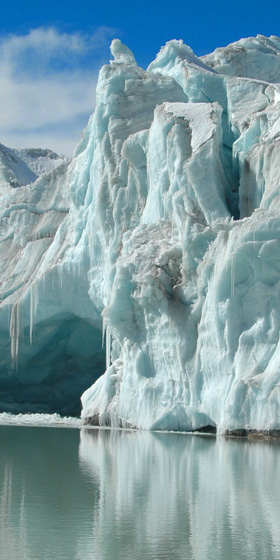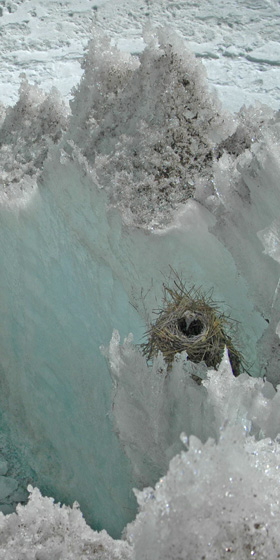Glacier Bird of the Andes: Diuca speculifera


Quelccaya Ice Cap photos (D. Hardy, K. Castañeda) |
||||||
IntroductionPerú’s Quelccaya Ice Cap is the largest tropical glacier on Earth (~50 km2), located at 14°S in the eastern Peruvian Andes (Cordillera Vilcanota). With a summit elevation of 5,670 meters (18,600 feet), the glacier has been a foci of high-elevation climate and paleoclimate research for more than 30 years (esp. Ohio State). Beyond Quelccaya’s current ice margin, recessional moraine complexes have formed extensive wetlands (bofedals). Today, the area is ecologically vibrant, diverse and productive, maintained by meltwater runoff from the glacier – but rapid environmental change is underway as the ice cap recedes.
In the course of 2003 fieldwork, our curiosity was piqued by finding an apparent bird nest attached to the near-vertical ice margin, at 5,180 m (17,000 ft). Ornithologists were also puzzled by this observation, so in subsequent field seasons we investigated further. This website presents images and information to supplement our paper “White-winged Diuca Finch (Diuca speculifera) Nesting on Quelccaya Ice Cap, Perú” published September 2008 in the Wilson Journal of Ornithology. A PDF version of the paper is available here (or here in very high resolution). The Encyclopedia of Snow, Ice and Glaciers (Springer, 2011) contains a synopsis, available here. Two elements of White-winged Diuca Finch nesting are particularly noteworthy:1. They are among the highest-elevation nesting birds of the Western Hemisphere, if not the highest nesting (to at least 5,300 m at Quelccaya - see paper). 2. Their lives at Quelccaya Ice Cap are intimately associated with the glacier (i.e., nocturnal roosting, nesting). Among ~10,000 other bird species, only the Emperor Penguin (Aptenodytes forsteri) is also associated directly with glacier ice (and does not construct nests per se). In both cases our observations are not the first (cf. Niethammer, 1953 [in German]; Johnson, 1967), although details and photographs have not been documented previously, to our knowledge. UPDATE - July 2018The BBC Glacier Bird footage will premiere in the United States this month. Kingdoms of the Sky is the PBS version of the BBC series Mountain: Life at the Extreme, which aired in the UK last September.Kingdoms of the Sky is a three-part documentary series "revealing the extraordinary animals and remarkable people who make a home on the iconic mountain ranges of the world - Rockies, Himalaya and Andes." The series website is here. The three episodes will initially air on Wednesday evenings, beginning with The Rockies on July 11 at 9 PM EDT. Himalaya premieres one week later on July 18, and Andes premieres on July 25. Links to selected video clips from the series are available now, on the right-hand side of the series homepage. Click on "Meet the Bird that Nests Inside Glaciers" to see the first-ever footage of Diuca speculifera nestlings. The Andes segment concludes with a Behind the Scenes look at Quelccaya filming; don't miss this! DVDs of the entire series can be pre-ordered now. Also, our manuscript with new details about Diuca speculifera and other species of the High Andes is still in review, due to editorial processing changes at the WJO. So, contact us for a synopsis of the paper, or a pre-print. UPDATE - September 2017In April & May 2016 we organized an expedition with the BBC Natural History Unit to learn more about the breeding biology of Diuca speculifera, and capture the first footage of active glacier nests. Our team spent more than two weeks at the site, and learned a great deal about diuca-finches as well as other species living in the area; we have now found two species which nest on glacier ice! The Glacier Bird segment aired in the UK on 13 September, and will be available elsewhere in the world soon. Check the program's website here or learn more here.A new manuscript on Diuca speculifera and other species, titled "Avian nesting and roosting on glaciers at high elevation, Cordillera Vilcanota, Peru" is now in review for publication in the Wilson Journal of Ornithology (Hardy et al.). This paper expands upon the initial findings we published in 2008. Please let us know if you would like to read a pre-print. Additional Images and InformationAcknowlegementsFieldwork in the Quelccaya Ice Cap area is supported by the National Science Foundation and NOAA Office of Global Programs, Climate Change Data and Detection Program (Grant No. 0402557, awarded to DRH), and by the U.S. Global Climate Observing System. Any opinions, findings, and conclusions or recommendations expressed in this material are those of the authors (D.R. Hardy and S.P. Hardy) and do not necessarily reflect the views of the National Science Foundation or NOAA. Fieldwork support in 2009 was also provided by the Explorers Club and the Wilson Ornithological Society, through awards to SPH. We gratefully acknowledge the able field assistance of Mathias Vuille, Carsten Braun, and D. R. Dockstader, along with Mountain Guides Felix Vicencio, Koky Castañeda, and Vicencio Expeditions staff. Initial discussion of the glacier nests with Jon Fjeldså, Alvaro Jaramillo, Manuel Plenge, and George Clark was helpful and encouraging. Carla Dove at the Smithsonian Institution (Washington, D.C.) undertook feather identification in her laboratory and provided considerable enthusiasm. We love Mountain Hardwear tents, clothing, and packs! |
||||||
Doug Hardy, UMass Geosciences